Wednesday, April 09, 2008
We'll be back soon!
Sorry for not posting recently, we've been busy traveling and will share some more soon! You might have noticed on our daily photo blog that we're on our way back to the U.S., but once we get settled a bit we'll share a little more from our travels in Europe.
Wednesday, February 20, 2008
Christmas in Spain
The Andalucia region of Spain made for a really nice Christmas break. The area has everything we like -- from mountains to sea, city to rural, and of course food and wine! Christmas turns out to be a pretty laid-back affair in most of Spain. There were plenty of decorations and nativity scenes, as well as some street performers and a market in Seville. The main gift-giving occasion is after Christmas in early January, when Spain celebrates Three Kings day (Dia de los Reyes Magos).
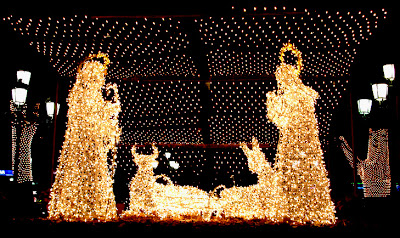
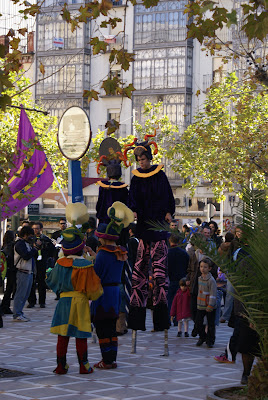
Pictured are a nativity scene (belen) from Granada and a group of street performers from Jaen.

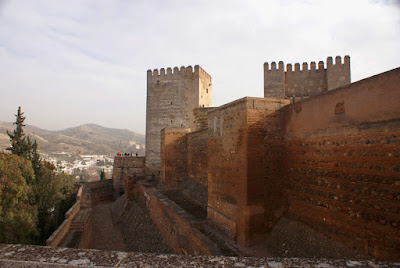
We call this our "car" trip, since the major cities sound like a list of bad 70's American autos. Our first stop, Granada, is most famous for the Alhambra palace. Situated high above the city, the Alhambra is an impressive sight, combining the Moorish architecture of the Muslim kings with european renaissance buildings introduced after the christians regained control. The intricate designs in the wood, plaster, and stone are amazing. Photos above and below are from Alhambra.
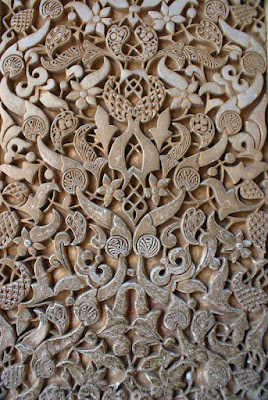
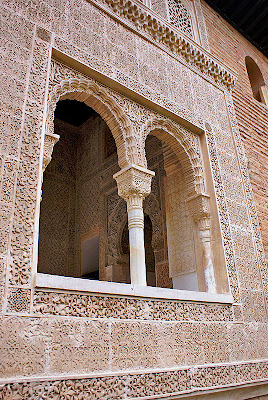



This region is truly tapas-land. Everywhere you go, when you walk into a bar and order a glass of beer or wine, you get handed a plate of tapas with each round. And each round is usually a different sort of tapas. If you want you can order additional plates and really make a meal out of it. Or, you can walk out after 2-3 rounds, having only spent 8-12 euros, and be pretty satisfied. In some places it gets so crowded you can barely stand -- especially during siesta, when all of the shoppers and shopworkers cram themselves into the most popular places. Not always the most comfortable, but definitely a great value!
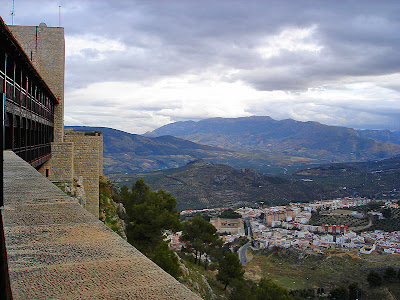

We spent 3 nights, including Christmas, at a Parador in Jaen. Paradors are government-run hotels, many of them built in or near historic buildings. The Jaen parador is built on the Castillo de Santa Catalina, an arab castle captured by the catholic kings and later sacked by Napoleon's army. Terrific views of the city and the surrounding olive groves greeted us in the morning. The photos above are from our room and of the hotel/castle. Below are more photos from the castle and the town's cathdral dating from 1570.



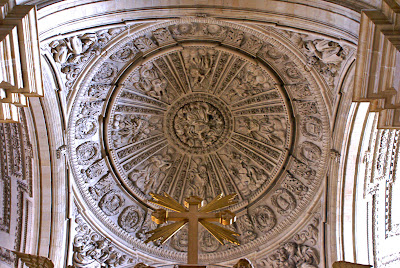
We took two day trips from Jaen. First to Cordoba, home of a magnificent cathedral, which is adapted from a moorish mosque.


Pictured above: Moorish architecture inside the Cordoba cathedral
Many of the towns we visited tout their Columbus connection, some of them more believable than others. But just about every major city in the area has a Columbus statue of some sort. It's said that he first proposed his trip at the castle in Jaen although others say it was outside of Granada. Seville's cathedral contains Columbus' tomb, although it's disputed whether his remains are actually there. He set sail from Cadiz. Below is a scene from the Alcazar garden in Cordoba, showing Columbus as he receives his commission from Isabella and Ferdinand.
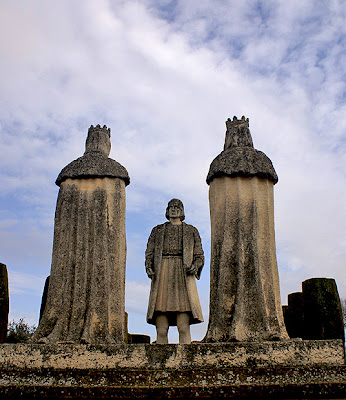
Our second day trip was to Ubeda, a nearby town with some nice renaissance buildings (and another crowded but good tapas bar). We drove further to the Cazorla nature reserve, where we were treated to some pretty exciting driving (there are no barriers on the steep side of the road) and pretty forest scenery. You can see some of the higher snow-covered peaks of the Sierras poking out from the forest.
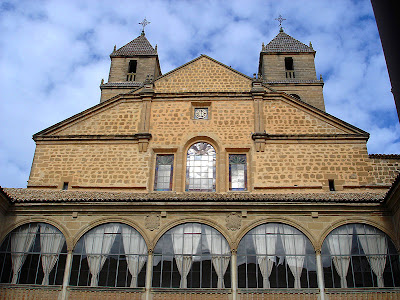
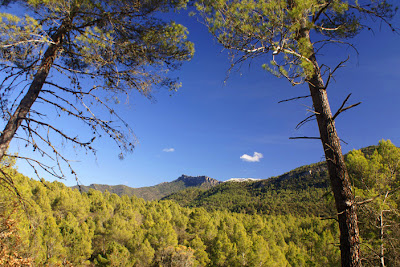
Pictured: renaissance courtyard in Ubeda; the forest and mountains of Cazorla
On the way out of Jaen we stopped in the "white town" (so called because of the white wash on the outside of the buildings) of Ronda. A lot of sights are packed into this small town. There's a deep gorge running through it (along with the puente nevo bridge dating from the 18th century). There are plenty of interesting buildings like the Salvatierra palace with it's interesting Indian-inspired columns (dubbed the "gotta pee" building). And it's known as the home of modern bullfighting. Some of the Ronda sights are pictured below.

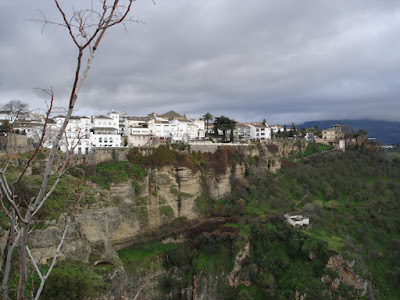



We stayed two nights in the resorty area of the Costa del Sol in order to take a daytrip to Morocco. The area between Malaga and Gibralter might as well be called Little Britain ... there's so much british influence there you feel more like you're in a spanish-themed town somewhere in the UK. We can understand why it's so popular -- in the sunny season it's a world away from the dull grey. But it's not our kind of area, even in the off season when the big hotels seem empty without the hordes of people heading for the beach.
The trip to Tangiers was precisely as we expected. For those of you who've been over the border from the U.S., we liken it to Tijuana. The tour group was herded off the ferry onto a bus where we were dropped at strategic points designed to get the most stereotypical view of Morocco: camel rides, a rug market, an apothecary store. All the while practically mobbed by street vendors selling cheap trinkets as we walked through the casbah (the old fortified center of town). It was pretty amusing, as it's what we expected. And we did touch our feet on Africa, which was our goal. And we did get a new phrase to laugh at occasionally, which came from the rug salesman -- "Touch My Rug!!!"

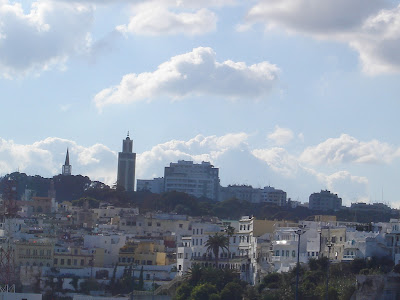
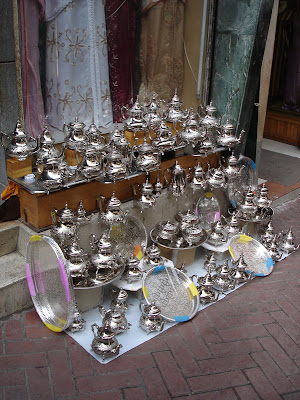
Pictured above: camel rides, Tangiers skyline, wares displayed in the casbah
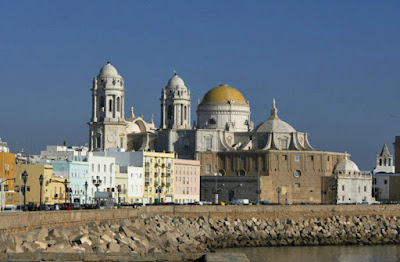
On our way to Seville we made a sidetrip along the western coast town of Cadiz (pictured above). It's easy to see why this is a popular resort town, with it's colorful buildings, picturesque cathedral, and long stretch of beach.
Seville was a really pleasant city (other than driving to and from our hotel, which was a nightmare in the small one-way streets). The old town is dominated by the cathedral, once again a mosque that was adapted and is said to be the largest (by volume) cathedral in europe. The Plaza de Espana is a large pavilion built for the 1929 Ibero-America exhibition. It contains tiled vignettes from each of Spain's provences. We noticed that it was popular for Spanish tourists to sit and have their pictures taken in their province's space.
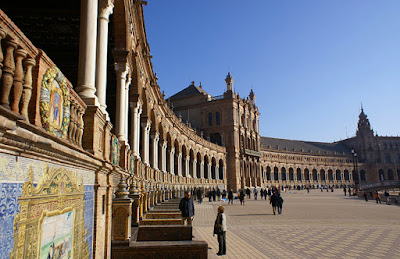
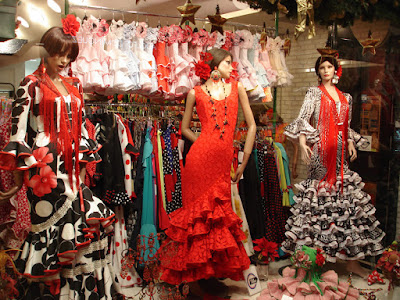
Pictured above: the Plaza de Espana, built for the 1929 exhibition, and flamenco dresses for sale
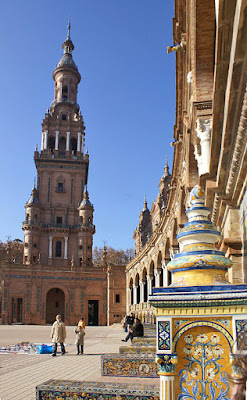

Pictured above: more of the Plaza de Espana, and the cathedral's Giralda tower at night
Our day trip from Seville was out to the Coto Donana national park. We chose to hike around the nature areas, which was really pleasant on a mild winter day. Along the way we saw many birds, lizards, and a pair of storks nesting on the tower of the visitor's center. On the way back to Seville we stopped outside of El Rocio, which is famous for it's religious pilgrimage. It's a strange scene looking to the brilliant white church (below); there are horses in the mudflats along with many different types of waterfowl. In fact, if you look closely at the 2nd photo you can see flamingos in the background -- the first time we've seen them in the wild.
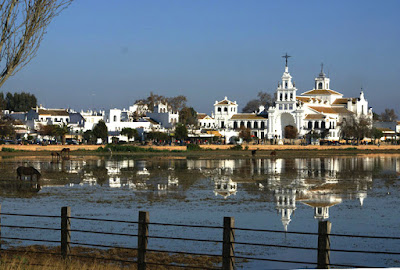
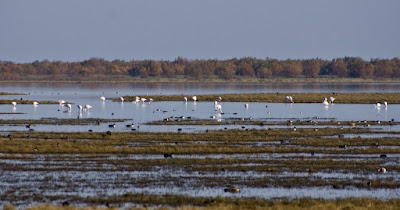
Although we only visited one province, we found that Andalucia was a great place to experience different aspects of Spain. It was definitely a good choice for a winter holiday.


Pictured are a nativity scene (belen) from Granada and a group of street performers from Jaen.


We call this our "car" trip, since the major cities sound like a list of bad 70's American autos. Our first stop, Granada, is most famous for the Alhambra palace. Situated high above the city, the Alhambra is an impressive sight, combining the Moorish architecture of the Muslim kings with european renaissance buildings introduced after the christians regained control. The intricate designs in the wood, plaster, and stone are amazing. Photos above and below are from Alhambra.





This region is truly tapas-land. Everywhere you go, when you walk into a bar and order a glass of beer or wine, you get handed a plate of tapas with each round. And each round is usually a different sort of tapas. If you want you can order additional plates and really make a meal out of it. Or, you can walk out after 2-3 rounds, having only spent 8-12 euros, and be pretty satisfied. In some places it gets so crowded you can barely stand -- especially during siesta, when all of the shoppers and shopworkers cram themselves into the most popular places. Not always the most comfortable, but definitely a great value!


We spent 3 nights, including Christmas, at a Parador in Jaen. Paradors are government-run hotels, many of them built in or near historic buildings. The Jaen parador is built on the Castillo de Santa Catalina, an arab castle captured by the catholic kings and later sacked by Napoleon's army. Terrific views of the city and the surrounding olive groves greeted us in the morning. The photos above are from our room and of the hotel/castle. Below are more photos from the castle and the town's cathdral dating from 1570.




We took two day trips from Jaen. First to Cordoba, home of a magnificent cathedral, which is adapted from a moorish mosque.


Pictured above: Moorish architecture inside the Cordoba cathedral
Many of the towns we visited tout their Columbus connection, some of them more believable than others. But just about every major city in the area has a Columbus statue of some sort. It's said that he first proposed his trip at the castle in Jaen although others say it was outside of Granada. Seville's cathedral contains Columbus' tomb, although it's disputed whether his remains are actually there. He set sail from Cadiz. Below is a scene from the Alcazar garden in Cordoba, showing Columbus as he receives his commission from Isabella and Ferdinand.

Our second day trip was to Ubeda, a nearby town with some nice renaissance buildings (and another crowded but good tapas bar). We drove further to the Cazorla nature reserve, where we were treated to some pretty exciting driving (there are no barriers on the steep side of the road) and pretty forest scenery. You can see some of the higher snow-covered peaks of the Sierras poking out from the forest.


Pictured: renaissance courtyard in Ubeda; the forest and mountains of Cazorla
On the way out of Jaen we stopped in the "white town" (so called because of the white wash on the outside of the buildings) of Ronda. A lot of sights are packed into this small town. There's a deep gorge running through it (along with the puente nevo bridge dating from the 18th century). There are plenty of interesting buildings like the Salvatierra palace with it's interesting Indian-inspired columns (dubbed the "gotta pee" building). And it's known as the home of modern bullfighting. Some of the Ronda sights are pictured below.





We stayed two nights in the resorty area of the Costa del Sol in order to take a daytrip to Morocco. The area between Malaga and Gibralter might as well be called Little Britain ... there's so much british influence there you feel more like you're in a spanish-themed town somewhere in the UK. We can understand why it's so popular -- in the sunny season it's a world away from the dull grey. But it's not our kind of area, even in the off season when the big hotels seem empty without the hordes of people heading for the beach.
The trip to Tangiers was precisely as we expected. For those of you who've been over the border from the U.S., we liken it to Tijuana. The tour group was herded off the ferry onto a bus where we were dropped at strategic points designed to get the most stereotypical view of Morocco: camel rides, a rug market, an apothecary store. All the while practically mobbed by street vendors selling cheap trinkets as we walked through the casbah (the old fortified center of town). It was pretty amusing, as it's what we expected. And we did touch our feet on Africa, which was our goal. And we did get a new phrase to laugh at occasionally, which came from the rug salesman -- "Touch My Rug!!!"



Pictured above: camel rides, Tangiers skyline, wares displayed in the casbah

On our way to Seville we made a sidetrip along the western coast town of Cadiz (pictured above). It's easy to see why this is a popular resort town, with it's colorful buildings, picturesque cathedral, and long stretch of beach.
Seville was a really pleasant city (other than driving to and from our hotel, which was a nightmare in the small one-way streets). The old town is dominated by the cathedral, once again a mosque that was adapted and is said to be the largest (by volume) cathedral in europe. The Plaza de Espana is a large pavilion built for the 1929 Ibero-America exhibition. It contains tiled vignettes from each of Spain's provences. We noticed that it was popular for Spanish tourists to sit and have their pictures taken in their province's space.


Pictured above: the Plaza de Espana, built for the 1929 exhibition, and flamenco dresses for sale


Pictured above: more of the Plaza de Espana, and the cathedral's Giralda tower at night
Our day trip from Seville was out to the Coto Donana national park. We chose to hike around the nature areas, which was really pleasant on a mild winter day. Along the way we saw many birds, lizards, and a pair of storks nesting on the tower of the visitor's center. On the way back to Seville we stopped outside of El Rocio, which is famous for it's religious pilgrimage. It's a strange scene looking to the brilliant white church (below); there are horses in the mudflats along with many different types of waterfowl. In fact, if you look closely at the 2nd photo you can see flamingos in the background -- the first time we've seen them in the wild.


Although we only visited one province, we found that Andalucia was a great place to experience different aspects of Spain. It was definitely a good choice for a winter holiday.
Thursday, January 10, 2008
Prague
We went to Prague, with our friend Cathy from Michigan, expecting it to be our most challenging european trip to date. After all, we were visiting a place where we couldn't even begin to pronounce the street names, let alone ask for something in a store or restaurant. And the Czech Republic is known for a cold surliness, right?

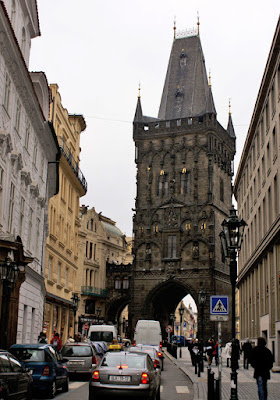
Pictured above: Tyn church (Rochelle calls it "Evil Disney"), Powder Gate
To our surprise, it was more english-friendly than many other european cities. And while not everyone was happy-smiley-friendly, it wasn't all grumbles, either. The food is fairly cheap (in european terms anyway) but hearty. More pork knuckles and potatoes than you can imagine, not that we're complaining.



Pictured above: Tyn church at night, Astronomical Clock, and the crowd waiting for the clock to strike the hour
Good thing, because what we were grumbling about was the weather. After a bit of sun on our first day, it was grey dreariness the rest of the week. I mean, we expected some of that -- it was November after all -- but we are starting to think that mother nature is hell-bent on having every european capital trip we take be under a blanket of grey gloom.
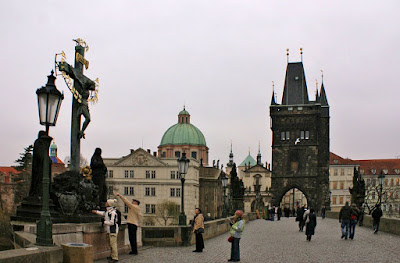

Pictured above: The Charles Bridge, day and evening
There is a definite charm to Prague, despite the countless number of souvenir and glass shops that dominate the old town. The bohemian architecture is very distinctive, even more so for being mixed in with the more familiar european styles of gothic, neo-classic, and art nouveau.

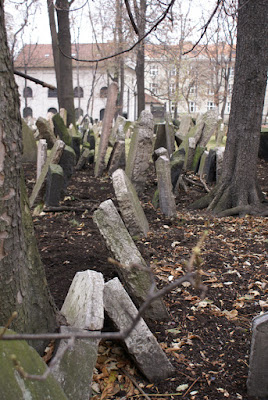
Pictured above: scenes from the Jewish Cemetery
Each area of the city has such a distinctive feel: old town with it's touristic hubbub, the relative quiet of the jewish quarter, the Vinohrady (with it's Paris-like feel of endless continental-style apartment blocks), and the Vysehrad cemetery, where we found the graves of the famous composers Smetana and Dvorak.

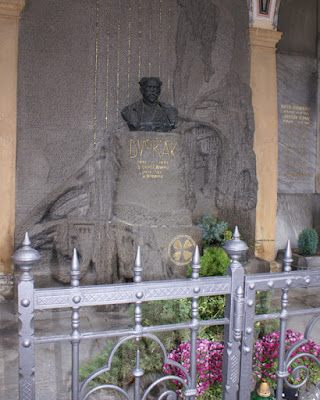
Pictured above: from the Vysehrad graveyard (Dvorak's grave on right)
Our day trip to Kutna Hora started out with an annoying delay due to a mixup with some of the passengers. The trip was worth it -- we saw snow on part of our route and really enjoyed the gothic cathedral which is the centerpiece of the town.

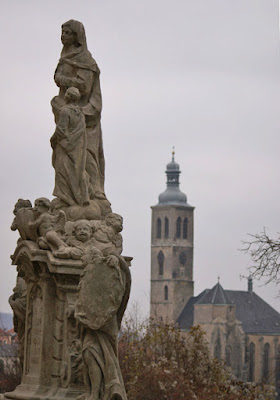
Pictured above: St. Barbara and view from Kutna Hora
Our tourguide was accidentally hilarious ... she started every sentence with "I would like to say..." and rushed us around as we tried to make up for lost time. She did pull off a minor miracle in getting the Sedlec Ossuary to stay open an hour past normal closing time, and we're glad she did. It's an amazing sight to see a church decorated with the bones of over 40,000 skeletons.
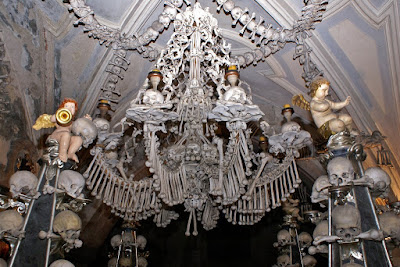

Pictured above: from the Ossuary
There's a lot to remember from this trip: the company of a friend, the sight of the crowd at the astronomical clock (and the following "that's it?" expressions), the joyful playing of a quartet at Prague Castle, and the unique architecture.


Pictured above: in the area of the Prague Castle
Join us in 2 weeks for a recap of our Christmastime trip to Spain.


Pictured above: Tyn church (Rochelle calls it "Evil Disney"), Powder Gate
To our surprise, it was more english-friendly than many other european cities. And while not everyone was happy-smiley-friendly, it wasn't all grumbles, either. The food is fairly cheap (in european terms anyway) but hearty. More pork knuckles and potatoes than you can imagine, not that we're complaining.



Pictured above: Tyn church at night, Astronomical Clock, and the crowd waiting for the clock to strike the hour
Good thing, because what we were grumbling about was the weather. After a bit of sun on our first day, it was grey dreariness the rest of the week. I mean, we expected some of that -- it was November after all -- but we are starting to think that mother nature is hell-bent on having every european capital trip we take be under a blanket of grey gloom.


Pictured above: The Charles Bridge, day and evening
There is a definite charm to Prague, despite the countless number of souvenir and glass shops that dominate the old town. The bohemian architecture is very distinctive, even more so for being mixed in with the more familiar european styles of gothic, neo-classic, and art nouveau.


Pictured above: scenes from the Jewish Cemetery
Each area of the city has such a distinctive feel: old town with it's touristic hubbub, the relative quiet of the jewish quarter, the Vinohrady (with it's Paris-like feel of endless continental-style apartment blocks), and the Vysehrad cemetery, where we found the graves of the famous composers Smetana and Dvorak.


Pictured above: from the Vysehrad graveyard (Dvorak's grave on right)
Our day trip to Kutna Hora started out with an annoying delay due to a mixup with some of the passengers. The trip was worth it -- we saw snow on part of our route and really enjoyed the gothic cathedral which is the centerpiece of the town.


Pictured above: St. Barbara and view from Kutna Hora
Our tourguide was accidentally hilarious ... she started every sentence with "I would like to say..." and rushed us around as we tried to make up for lost time. She did pull off a minor miracle in getting the Sedlec Ossuary to stay open an hour past normal closing time, and we're glad she did. It's an amazing sight to see a church decorated with the bones of over 40,000 skeletons.


Pictured above: from the Ossuary
There's a lot to remember from this trip: the company of a friend, the sight of the crowd at the astronomical clock (and the following "that's it?" expressions), the joyful playing of a quartet at Prague Castle, and the unique architecture.


Pictured above: in the area of the Prague Castle
Join us in 2 weeks for a recap of our Christmastime trip to Spain.
Subscribe to:
Posts (Atom)

